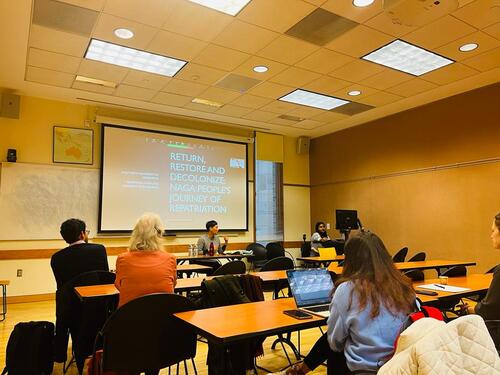Since 1884, The Pitt Rivers Museum (PRM) in Oxford, England, has held in its collection artifacts and remains belonging to the Naga peoples of Northeast India. In 2020, the museum and the Forum for Naga Reconciliation (FNR), a convening body for the Naga peoples, began conversations around the future of those holdings. On Thursday, February 9, in the first South Asian Studies Colloquium of the Spring 2023 semester, Professor Dolly Kikon, Henry Hart Rice Visiting Associate Professor at the MacMillan Center for 2023, and Dr. Arkotong Longkumer, Senior Lecturer in Modern Asia at the University of Edinburgh, reflected on the ongoing dialogue on the repatriation of Naga ancestral human remains and shared how the process has started a journey of healing, reconciliation, and decolonization for the Nagas. Kikon and Longkumer together serve as research leaders of Recover, Restore, and Decolonize (RRaD), which was founded by the FNR in 2021. The aim of RRaD is to initiate research, dialogue, and conversations for the return of Naga ancestral human remains from Oxford to Nagaland. More than 40 people attended the hybrid lecture.
Kikon began her presentation by situating RRaD in international indigenous dialogues about healing, repatriation, and the process of decolonization, taking examples from Australia to India to the United States, and then explaining RRaD’s genesis in Kikon’s outreach to Professor Laura Van Broekhoven, Director of the Pitt Rivers Museum, in 2020. At the time, the COVID-19 pandemic was in its early stages, so the FNR and PRM began organizing Zoom conversations with Naga elders that lasted into 2021. In 2021 RRaD was officially formed, and the first Naga public lecture on repatriation and decolonization was held in Dimapur, the largest city in Nagaland. Since 2021, Kikon and Longkumer have continued to hold lectures, engagements, and reflections throughout Nagaland, where Kikon described an upswell of interest and engagement. The process has also necessitated figuring out how to talk about decolonization and repatriation to Nagas of all ages.
A signal moment of the dialogues was the publication of “The Unfinished Business of Colonialism,” an article by Kikon and Longkumer, in the Morung Express, a Nagaland newspaper. The story was picked up by The Wire, a major Indian news outlet, but Kikon explained that RRaD has worked to keep stories around repatriation centered on the Naga peoples rather than audiences in Delhi. She emphasized that collaboration with Naga elders, students, researchers, and journalists forms an important part of RRaD.
After explaining RRaD, Kikon moved on to explaining the ongoing effects of colonization on the Nagas. She read an excerpt of a speech she had given in December 2022 that talked about how “as a Naga student I grew up hearing how the authoritative book on my people was written by a British administrator.” She also discussed the continued portrayal of Nagaland and the Nagas with romanticized, colonial stereotypes. Referencing one article published in The Guardian in 2007 that described Nagaland as a “lost world,” she joked, “I don’t know how it can be lost. At the time I was at Stanford doing my PhD.” Before concluding, she read a powerful poem by the late Naga poet Temsüla Ao and showed a video—“Ancestral Human Remains and the Naga Homeland”—produced by the Pitt Rivers Museum and featuring Kikon and Longkumer that discusses the ongoing dialogue.
After Kikon’s presentation, Longkumer discussed the RRaD website and the organization’s efforts to bring the story of the Nagas and the repatriation dialogue to a broader audience through a newly-published graphic novel called A Path Home, which explores the history and present of the Nagas. Written by Longkumer and illustrated by Naga illustrator Meren Imchen, the graphic novel wrestles with all the challenges of what Longkumer described as a “complex and sensitive region.” In his presentation, Longkumer went in-depth into the conception and writing of the graphic novel’s important elements. For a panel featuring a Naga home, for example, he explained that he and Imchen had a number of associations in mind when creating the panel: “A Naga household is where you eat, smoke meat, dry your chilies, hang baskets, and talk in the evenings around the fire.” So they focused on ensuring that the home depicted in the graphic novel captured those elements and would feel like an appealing space to Naga readers. Longkumer said that at its core, A Path Home is about human dignity: what it means to be human, the cycles of life, and the idea that to be human is to be part of a community, including in death. The Naga whose remains are in the Pitt Rivers Museum, he explained, have been temporarily removed from their community and dialogue around repatriation is a step in bringing them back.
Over the course of the COVID-19 pandemic, the Pitt Rivers Museum took 120 Naga ancestral human remains off display. That constitutes a little over half of the 213 clearly human remains at the museum, which are in turn a small set of the 6,466 Naga artifacts at the museum, the largest collection of Naga objects anywhere in the world. Kikon sees the dialogue and RRaD as a journey: a long and continuing process given the scale and complexity of the issues they are tackling. “If we can cover even 5% of the vision and objectives by the time I retire, I will consider myself lucky,” she said. Her presentation sought to underline the intergenerational work that processes of repatriation and healing require, and called on young Nagas to prepare themselves to join the journey of repatriation, reconciliation, and decolonization.
Byline: Daevan Mangalmurti


